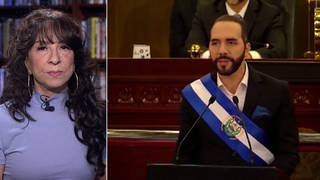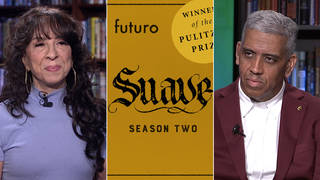
Topics
Guests
- Anabel HernándezMexican investigative reporter who was awarded the 2012 Golden Pen of Freedom Award. Her latest book is Narcoland: The Mexican Drug Lords and Their Godfathers. She was the lead author of the investigation, “Iguala: The Unofficial Story.”
- Steve Fisherfellow at the Investigative Reporting Program at UC Berkeley Graduate School of Journalism with a focus on U.S.-Mexico relations. He is the producer of the award-winning documentary, Silent River, in which a young Mexican woman defies death threats to defend her town against industrial pollution.
Sept. 26 marks the first anniversary of the disappearance of 43 students from the Ayotzinapa teachers’ college in Mexico. The students were attacked by local police and subsequently went missing from Iguala in the southern Mexican state of Guerrero. A report released earlier this month by independent experts with the Inter-American Commission on Human Rights found no evidence to support the government’s claim that the students were incinerated in a trash dump in a neighboring town. We speak to two journalists who have closely investigated the disappearances. Anabel Hernández is a Mexican investigative reporter. She was the lead author of the investigation, “Iguala: The Unofficial Story.” She and Steve Fisher are fellows at the Investigative Reporting Program at UC Berkeley Graduate School of Journalism.
Transcript
AMY GOODMAN: This is Democracy Now!, democracynow.org, The War and Peace Report. I’m Amy Goodman, with Juan González.
JUAN GONZÁLEZ: Well, Pope Francis’s historic visit to the United States drew tens of thousands of the faithful, who braved the crowds just to get a glimpse of the pontiff. But one delegation of women traveled nearly 2,000 miles, from Ayotzinapa, Mexico, to try to meet with the pope in Philadelphia, hoping to bring attention to the plight of their missing sons. Saturday, September 26th, marks the one-year anniversary of the disappearance of 43 students from Ayotzinapa’s teachers’ college in Mexico. Parents of the missing students met with President Enrique Peña Nieto ahead of the anniversary of the students’ disappearance.
AMY GOODMAN: The students were attacked by local police and subsequently went missing from Iguala in the southern Mexican state of Guerrero. The initial series of attacks killed six people, one of whom was found with the skin of his face peeled off. The disappearance of the students has sparked ongoing protests and demonstrations. The unrest only intensified last November after then-Mexican Attorney General Jesús Murillo Karam announced that suspects in the case had admitted to killing the students and incinerating their bodies, and that the attack was ordered by the mayor of Iguala, who had turned the students over to a local drug gang. However, a report released earlier this month by independent experts with the Inter-American Commission on Human Rights found no evidence to support the government’s claim that the students were incinerated in a trash dump in a neighboring town of Cocula. Francisco Cox, one of the five members of the group of experts commissioned by the IACHR, spoke to the unlikelihood that the 43 students could have been burned there.
FRANCISCO COX: [translated] The flame of seven meters would have had to tilt toward the dump, igniting all the plastic that still existed. It is a rather dry dump, and therefore there should have been a forest fire, a fire that would have burned this whole area. For all these reasons, the GI has formed the belief that the boys were not incinerated in the dump of Cocula.
JUAN GONZÁLEZ: Mexico has announced it will now seek a new investigation. Though the group of experts affirms the doubts the families of the missing students had of the Mexican authorities’ account that the students’ bodies were burned, it offers no answers as to what may have happened to the students. Family members are still left wondering what happened to their loved ones.
FAMILY MEMBER: [translated] People who have been brought in to make statements, supposedly, regarding the issue of the garbage, simply, the testimony is not consistent. Scientifically, it’s not viable that the, quote, “story” happened. But also, it’s a day of sadness, a day of sadness because we are on the verge of completing a year, and there’s nothing known about the whereabouts of the missing students.
AMY GOODMAN: For more on this first anniversary of the disappearance of the Ayotzinapa students, we’re joined by two journalists who helped break the story last year.
Anabel Hernández is a Mexican investigative reporter. She was awarded the 2012 Golden Pen of Freedom Award. Her latest book is called Narcoland: The Mexican Drug Lords and Their Godfathers. She was the lead author of the new investigation, “Iguala: The Unofficial Story,” which was published in the Mexican magazine Proceso, currently a fellow at the Investigative Reporting Program at UC Berkeley Graduate School of Journalism.
Steve Fisher is with us, fellow at the Investigative Reporting Program at UC Berkeley Graduate School of Journalism, as well, with a focus on U.S.-Mexico relations, producer of the award-winning documentary, Silent River, in which a young Mexican woman defies death threats to defend her town against industrial pollution.
We welcome you both to Democracy Now! Anabel Hernández, it’s the first anniversary of the death of these 43 teachers’ college students from this teachers’ college called Ayotzinapa. Tell us what you believe happened to them. What is known at this point?
ANABEL HERNÁNDEZ: Well, that night, on September 26 of 2014, more than 100 of students were attacked that night in the middle of Iguala, downtown Iguala, not just by the municipal police. We have documents, testimonies, videos, audios, that shows, that proves that in that attack not just participate the local police. In that attack, also participate was involved the federal police and the army, the militaries of Mexico. Since the beginning, the Mexican government, the federal government, tried to cover that. Since the beginning, the Mexican government said, “We didn’t know anything about the attack. Of course we didn’t participate. This was just something that was done by the mayor, José Luis Abarca, and by the local police, not us.” Now, one year later, all this independent commission from the Inter-American Commission of Human Rights proves also what we said since last December, where we published our first article about our investigation that guessed the federal police and the army participated. And the point is that until now these members of the government have been really not been investigated by the federal government.
JUAN GONZÁLEZ: And has the government now acknowledged the participation of federal—of federal troops and federal police? And if so, was this an order by a local commander, or did this come all the way from Mexico City?
ANABEL HERNÁNDEZ: Well, that is a good question, because the federal government knows that since the beginning. I mean, the federal government was monitoring to these students since four hours before the attack. And the federal government, not just local members of the federal government that was in Iguala at that night, also other high members, for example, exist in Mexico, many, many ranks in the militaries. And as you know, when one base in Iguala—when the base in Iguala start at 7:00 p.m. to produce—producing information, monitoring to the students, other ranks of the militaries also at the same time was noticed about it.
AMY GOODMAN: Steve Fisher, what are your thoughts on this new independent expert panel, the Inter-American Commission for Human Rights report on what happened to the students? And do you believe they were incinerated?
STEVE FISHER: First of all, having been working on this investigation with Anabel for 10 months, there was very little in the report that actually surprised us. It more corroborated the more than six articles that we had published from thousands and thousands of documents. We were looking at the same documents that the Inter-American Commission looked at. But yes, I think it just reiterates the fact that this was not, you know, a local mayor and his little gang of municipal police, and, you know, they did away with the students to a landfill. That was sort of like a way to tie it up in a neat little bow and say, you know, the responsibility is very local. And I think this, as we have been reporting, sort of highlighted the fact that this is very much a federal government issue. Were they burned in the landfill? It seems that there are so many studies that have been done now, including the Inter-American Commission study, that shows that it was almost entirely impossible that they would have been burned there that night.
JUAN GONZÁLEZ: And how is it—is it possible to have any kind of independent commission really look into what happened in Ayotzinapa? Because obviously if the federal government was directly implicated in one way or another, it becomes even more difficult to get to the truth.
STEVE FISHER: I think the Inter-American Commission for Human Rights, the group that was selected to do this investigation, I think that they’re very capable, they are very highly regarded, very professional in their work. And yes, I do believe it is—we are able to get to the truth of what happened that night. But I think, based on the thousands of documents that we’ve seen and seeing the investigation that the Mexican government has done, it’s hard to see how they will be able to actually carry out an investigation into their own federal forces and do so and find the truth.
AMY GOODMAN: Anabel Hernández, the Mexican government says they’ll reopen the investigation now that the Inter-American Commission has come up with their report. And Mexican President Peña Nieto has just met with a group of parents.
ANABEL HERNÁNDEZ: Yesterday.
AMY GOODMAN: Yes. What came out of that meeting? Do you have any faith in the Mexican government reopening an investigation? Could the mass protests around the killing of these 43 young men, these students who were training to be teachers, lead to the downfall of Peña Nieto?
ANABEL HERNÁNDEZ: Well, first, it’s important to say that, even that, the president said, “We will reopen the case.” The problem is that many of the proofs were disappeared—videos, bullets, blood, T-shirts with blood, shoes, that were proofs about who did it and who disappeared and all these things. These are not there anymore. So, reopening the case will be—is not really the answer to find the truth, also because the government had been protecting to all the members of the government, of course. So, this announcement will not stop the protest in Mexico. I mean, the families, the relatives are very disappointed. They expect more, even more compassion, from the Mexican president. They said that Peña Nieto was very indifferent yesterday. He was very indifferent to their pain. So, I think that the protests will be huge in Mexico—and not just in Mexico. I know that there will be protests also in other parts of the world, as you know, have been happening in all these months since that happened. So I think that the federal government is getting inside one bigger problem, because the federal government apparently has in their hands one burned piece of one of the students. And the big question is—
AMY GOODMAN: You mean that they say—
ANABEL HERNÁNDEZ: Remains.
AMY GOODMAN: —they’ve got the DNA of the—of one of the students, incinerated remains.
ANABEL HERNÁNDEZ: Yeah. The point is, if the Inter-American Commission of Human Rights says that the Cocula was impossible, that that didn’t happen, the question—
AMY GOODMAN: The incineration of the students.
ANABEL HERNÁNDEZ: Why the government has that piece? Where did the government get it? I think that is one of the big questions for the next weeks and months.
JUAN GONZÁLEZ: And the impact of this tragedy and this cover-up on Mexican society? You were talking about all the big protests that have occurred. What has this done to general public opinion in Mexico over the past year?
ANABEL HERNÁNDEZ: You know, the problem is that, of course, Mexicans knows—really can feel that government is lying. Of course, many people feel very, very angry about this case, because this case is not just about the 43 students. As you well know, in Mexico, thousands of people disappear, are murdered, are killed on the streets. But this is a good example what is—what is happening in Mexico, how many young people—not just these students, other young people—is really suffering this impunity and abuse of power and don’t—and the no respect of the human rights. So, I think that the public opinion really, really understand what is happening and really is with the relatives of these students.
AMY GOODMAN: Do you think it’s possible that the students are still alive? In April, two relatives of the missing students joined us in our studio here on Democracy Now! We asked Antonio Tizapa if he thought his son, Jorge Antonio Tizapa Legideño, was still alive.
ANTONIO TIZAPA: [translated] Absolutely, 100 percent. Like the rest of the parents, we are sure that they are alive. Independently, that what others say, that is completely false. We know that they are alive. We know that they are holding them alive, because they are being detained. We don’t know the reason. We do not know the reason.
AMY GOODMAN: What has the Mexican government told the families? Why don’t you believe it?
ANTONIO TIZAPA: [translated] Because the government says that this is a case that is a closed case. However, there is no evidence. There is no evidence that show us, that prove what the government says happened to them. And while there is no proof, we maintain that they are alive 100 percent.
AMY GOODMAN: That’s Antonio Tizapa talking about his son, Jorge Antonio. He believes that his son is alive. Is that possible, Anabel?
ANABEL HERNÁNDEZ: It’s a very hard question, you know, because—well, I’m an investigative journalist. I just can tell about the proofs that we have seen in these months. And sadly, the videos, the photographs, things, new proofs that we just get, shows that it’s difficult to think that they are still alive.
AMY GOODMAN: And the significance of the pope coming to the United States, families trying to meet with the pope in Philadelphia?
ANABEL HERNÁNDEZ: That is very moving, I have to say. That is very moving, because these people, these relatives, haven’t found justice in Mexico. The expect that maybe one word from the pope could change the heart—the heart—the heart of the Mexican government. And I don’t know if that will happen.
AMY GOODMAN: We want to thank you both for being with us, Anabel Hernández and Steve Fisher, both investigative reporting fellows at the University of California, Berkeley, Graduate School of Journalism. They broke the story of the disappearance of 43 students from Ayotzinapa teachers’ college in the southern state of Guerrero in Mexico. It’s the first anniversary of their disappearance. This is Democracy Now!, democracynow.org, The War and Peace Report. I’m Amy Goodman, with Juan González. Thanks for joining us.











Media Options